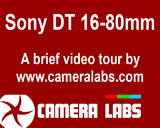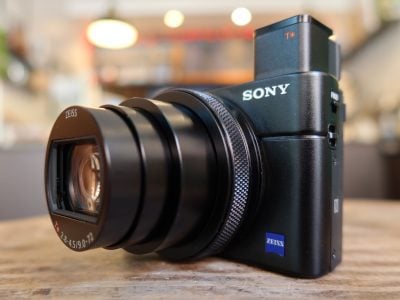Sony Vario-Sonnar T* DT 16-80mm f3.5-4.5 ZA
-
-
Written by Gordon Laing
Verdict
|
| ||||||||||||||||||||||
The Sony DT 16-80mm promises to be the perfect general-purpose zoom for discerning Alpha DSLR owners. With an equivalent range of 24-120mm it zooms both wider and longer than the standard kit lens, and with the pedigree of respected lens company Carl Zeiss behind it, the DT 16-80mm should have few concerns in the quality department.
In use the DT 16-80mm can certainly deliver excellent results. The range is much more flexible than the kit lens, and perfect as a single general purpose zoom. The optical quality is also of a much higher standard, with our Outdoor Results and Gallery pages revealing very well-corrected images with high contrast, sharp corners and minimal coloured fringing. It also managed to squeeze a little more resolution out of the A100 in our studio tests.
So far so good, but it’s not all positive. When upgrading to a premium lens, you generally expect improvements in both optical and build quality. But sadly while the DT 16-80mm does feature superior build quality to the standard kit lens (such as a metal mounting), it’s not as big a jump as you might be hoping for. Indeed in practice the DT 16-80mm and standard 18-70mm kit lenses are surprisingly close in look and feel, and don’t represent the difference you’d experience when making a similar upgrade on a rival manufacturer’s system.
As you’d expect, the DT 16-80mm now features a manual focusing ring, a window showing distance markings and internal focusing (so the end section doesn’t rotate), but like the kit lens it uses the Alpha’s built-in AF motor and as such the auto-focus performance is relatively slow and noisy compared to rival lens-based focusing systems. The gearing and mechanics behind the manual focusing ring are also quite obvious as you turn it and don’t feel anywhere as smooth or step-less as premium lenses from rival manufacturers.
In use the auto-focusing speed and noise were actually very similar to the kit lens, which may be fine for static or slow moving subjects, but often proved frustrating with faster moving subjects. We photographed some animals with the A100 and DT 16-80mm alongside a Canon 400D / XTi with the EF-S 17-85mm and the latter beat the Sony hands down in terms of focusing speed and noise.
So overall the DT 16-80mm is a mixed bag, and in terms of physical characteristics we have to admit to being disappointed. Don’t get us wrong, the DT 16-80mm isn’t poorly built by any means, but equally not the jump in quality over the kit lens we had hoped for from a premium Carl Zeiss model. The focusing was also disappointingly loud and slow for anyone who’s used Canon’s USM, Nikkor’s SWM, or indeed Sony’s own SSM systems.
But then you only have to look at our Outdoor Results and Gallery pages to see the DT 16-80mm can really deliver the goods in terms of optical quality. Sure, there’s some light fall-off when zoomed-out, but it’s not much worse than, say, Canon’s EF-S 17-85mm (which also only offers 27 to the Sony’s 24mm). Under real-life conditions, the DT 16-80mm is capable of delivering very sharp and detailed results across the entire frame, with minimal fringing and high contrast.
 |
So if you’re after a general purpose zoom for an Alpha DSLR with a flexible range and superb optical quality, then the Sony DT 16-80mm should certainly be high on your list. If however you’re looking for a lens which focuses much quicker than the kit model or offers a significant step-up in build quality, then you may be disappointed.
As such while we were very impressed by the optical quality of this lens, the other aspects prevent it from earning our Highly Recommended award. That said, with little or no competition at the time of writing, it still represents the best overall option for anyone wanting a high quality general-purpose zoom for an Alpha DSLR. So the Sony DT 16-80mm earns our Recommended rating, but just don’t expect a big improvement over the kit lens in terms of build quality or focusing.





